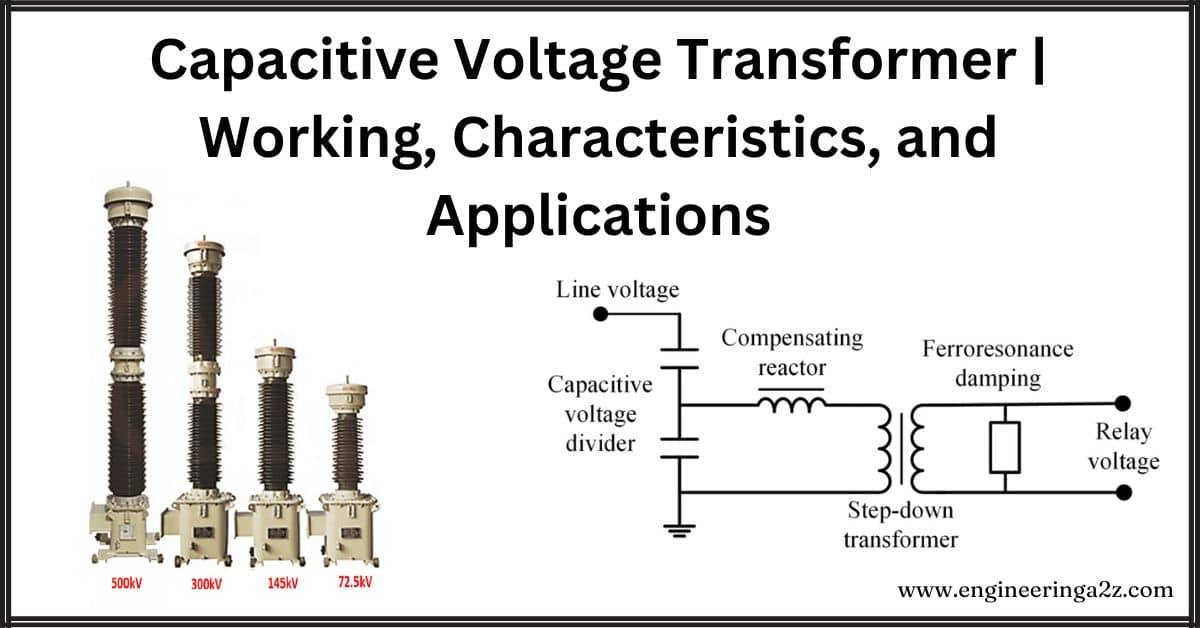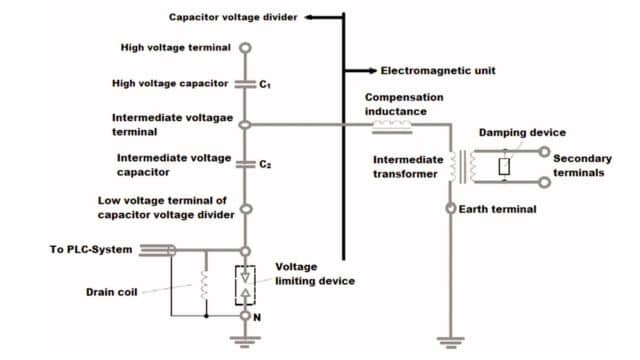
Table of Contents
Introduction
A Capacitive Voltage Transformer (CVT) is an essential component in power systems. It accurately measures high voltages by exploiting the capacitive division principle. Unlike traditional transformers, CVTs are lighter, smaller, and have better performance in high-voltage environments. They play a crucial role in ensuring precise voltage measurement for protection, control, and monitoring purposes in power grids.
What is a Capacitive Voltage Transformer?
A Capacitive Voltage Transformer (CVT) is a special tool used in big electrical systems to measure high voltages safely and accurately. It’s called a step-down transformer because it takes the high voltage in power lines and makes it lower so we can measure it easily.
Imagine it as having three important parts:
- Auxiliary Transformer: This part helps to power the CVT itself. It’s like the battery in your flashlight that keeps everything running smoothly.
- Inductive Element: This part helps to stabilize the voltage and make sure it’s consistent. It’s like having a steady hand while pouring water from a jug, so you don’t spill any.
- Capacitive Potential Divider: This is the main part that does the work of turning high voltage into a lower, safer voltage that we can measure. It’s like having a special tool that splits the big task into smaller, more manageable parts.
Working of Capacitive Voltage Transformer
A Capacitive Voltage Transformer (CVT) is a special device used in big electrical systems to measure high voltages safely and accurately. Here’s how it works in simple terms:
- Capacitor Bank: Think of it like having a bunch of batteries connected in a row. This helps to create a path for the high-voltage electricity to flow through easily.
- Electromagnetic Induction: Imagine the CVT is like a magic box connected to a high-voltage power line. The electricity in the power line creates a kind of invisible force field around it. The CVT uses this force field to figure out how much voltage is in the power line.
- Secondary Windings: Inside the magic box, there are coils of wire wrapped around a shield. These coils of wire are like antennas that pick up the voltage from the force field around the power line.
- Voltage Division: When the electricity flows through the power line, it creates a smaller version of the force field inside the magic box. This smaller force field induces a voltage in the coils of wire, which is like a smaller version of the voltage in the power line.
- Capacitive Voltage Divider: The CVT uses a clever trick with capacitors to make the smaller voltage even smaller and easier to measure. It’s like having a special tool that divides the big voltage into smaller, more manageable parts.
- Output and Accuracy: The smaller voltage is then used to measure or monitor the voltage level. CVTs are designed to do this accurately and safely, with minimal mistakes and good insulation to keep everything safe.

Characteristics of Capacitive Voltage Transformer
- External Configuration: It has a specific design layout visible from the outside.
- International Standards: It meets recognized global quality and safety standards.
- Insulation: It uses a special synthetic fluid-coated film paper for electrical insulation.
- Mineral Oil Insulation: Inside, there’s a part with mineral oil insulation, kept in the transformer’s bottom tank.
- Aluminium Alloy Components: All external metal parts are made of lightweight and durable aluminum alloy.
Advantages of Capacitive Voltage Transformer
- Simple Design: It’s easy to understand and use.
- Easy Installation: You can set it up without much hassle.
- Versatile Use: It can measure voltage and help with relaying in the power system. Also, it can assist in power line communication.
- Frequency Independent: It doesn’t care about the frequency of the electricity.
- Surge Protection: It’s built to handle electrical surges without extra insulation.
- Safe Isolation: It keeps high voltage separate from low voltage, preventing any sparks or discharge.
- Simple Commissioning: You can start using it quickly and easily.
- Long Life: Once installed, it’ll keep working reliably for a long time.
Disadvantages of Capacitive Voltage Transformer
- Voltage ratio is affected by temperature changes.
- Risk of ferro-resonance in power systems.
Applications of Capacitive Voltage Transformer
- Voltage Reduction: They make high voltages smaller and safer for measuring or using in protective relays.
- Metering and Protection: Used to accurately measure power consumption, protect against faults, and control power flow.
- Insulation: Keeps low-voltage circuits safe from high-voltage networks, ensuring the control room operators are protected.
- Power Line Communication: Can help with transmitting signals over power lines using high-frequency transmissions.
- Improved Fault Performance: Their high capacitance helps improve the performance of circuit breakers during short-line faults or when dealing with transient recovery voltages.
Frequently Asked Questions (FAQs)
What is the CVT transformer?
A Constant Voltage Transformer (CVT) is like a voltage regulator. It keeps the output voltage steady even when the input voltage fluctuates. In Chennai, suppliers provide high-quality CVTs made with special winding and capacitors. They’re used in tank circuits to ensure a stable output even if the input voltage is unstable, ensuring an uninterrupted power supply.
What is the working principle of CVT?
A common type of CVT works like this: it has a V-shaped belt that goes between two pulleys with variable sizes. These pulleys are made of two cone-shaped parts that can move closer or farther apart. When they move, the distance between them changes, affecting the effective size of the pulley. This mechanism helps adjust the speed smoothly without fixed gear ratios.
Why capacitor is used in CVT?
Capacitors in CVTs aid in voltage division, allowing accurate voltage measurement. They enhance performance and ensure stable output even with varying input voltages.
Read Also:
- Laplace Transform | Circuit Analysis, Use, and Applications
- Output Equation of Transformer
- Parallel Operation Of 1 Phase/ 3 Phase Transformers
- Three Phase Transformer | Construction & Working





Leave a Reply